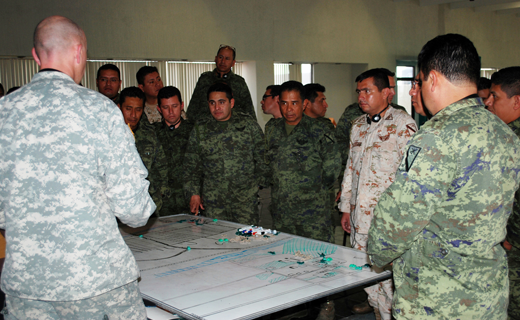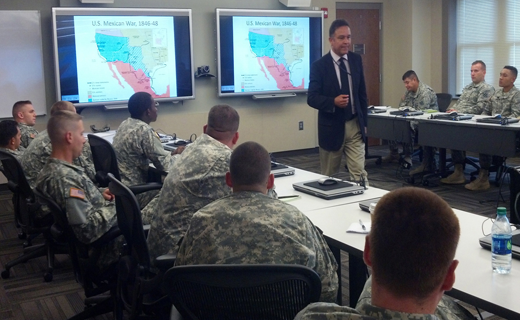Leveraging Sledgehammer Brigade to Build Enduring Partnerships in Shaping Tomorrow’s Security


Regionally aligned forces (RAF) provide capabilities to combatant commanders with agile, adaptable and focused general-purpose forces that can prevent, shape and win in today’s operational environment by generating Soldiers and organizations that are better trained for specific regions. Force alignment will allow strengthened relationships with other nations through partnered initiatives such as humanitarian, peacekeeping, border security, counter-narcotics and counterterrorism efforts.
The 3rd Armored Brigade Combat Team (ABCT), 3rd Infantry Division, regionally aligned to U.S. Northern Command (NORTHCOM) March 1, 2014, as the first brigade combat team (BCT) to assume the NORTHCOM RAF mission. The alignment focused the brigade to support the combatant commanders in two major efforts:
- Provide general-purpose quick-reaction force/rapid-reaction force.
- Provide support to theater-security cooperation (TSC) efforts. This was largely in the form of mobile-training-team (MTT) support in Mexico.
The TSC effort focuses on better shaping the NORTHCOM area of operations specific to Mexico, the Bahamas and Canada by strengthening ties with our allies through combined military training. The brigade supported the TSC effort through the deployment of multiple MTTs and unit exchanges. The NORTHCOM TSC effort fostered a cross-border relationship through sharing of tactics, techniques and procedures (TTPs), training methodology and lessons-learned in Iraq and Afghanistan to further improve each military for the collective security of North America.
As a North Atlantic Treaty Organization ally with a common language and having fought alongside each other in recent years, exchanges with Canada were largely focused on interoperability in the form of exercises or competition. This article will focus on the brigade’s effort with Mexico.
After several iterations of MTTs in Mexico, several lessons were identified during the process of preparing each MTT and are highlighted in three key phases: team selection, preparation and execution. In addition to these lessons-learned, the relationship established between the brigade and Army North (ARNORTH)’s Security Cooperation Division created an environment that fully supported and enabled each team deployed.
Team selection
Determining the size and composition of the MTTs was critical to establishing a credible, adaptable and cohesive team achieving tactical success for each mission in a strategic-level operation. The objective of each MTT was to provide training within the subject matter and, more importantly, promote a positive relationship with the Mexican army, Secretaría de la Defensa Nacional (SEDENA). To accomplish this, the brigade manned, trained and equipped each team consisting of six to 10 competent and combat-experienced personnel. Size and composition were factors that ensured the brigade selected a professional team capable of representing the U.S. Army.
Each MTT consisted of six to 10 commissioned and noncommissioned officers (NCOs) selected specifically for each MTT mission program of instruction (PoI). The small-professional-team model allowed ARNORTH flexibility with a prepared team that could quickly respond based on political factors between Mexico and the United States. An important component of the MTT went beyond the classroom instruction and involved personal relationships, which included SEDENA hosting our Soldiers at social events and touring local cultural sites near the training area, underpinning the cultural exchange portion of the mission.
Also, the instructor-to-trainee ratio was critical in shaping the environment for both the U.S. and SEDENA Soldiers to be successful. ARNORTH’s Security Cooperation Division coordinated with SEDENA to manage class sizes specifically to the six to 10 Soldier MTTs to ensure quality training. The small team composition fostered a peer-to-peer training environment, allowing U.S. and SEDENA Soldiers to interact on a personal level. Smaller training teams also, as an added benefit, were less resource-intensive for both ARNORTH and SEDENA beyond providing the optimal instructor-student ratio.
The composition of each team required NCOs and officers whose understanding of their craft went beyond technical and tactical competence. MTT members needed to have a deep grasp of how to apply their skills outside U.S. Army doctrine. The ability to communicate these skills across language barriers and translation between national doctrinal differences requires a level of proficiency and understanding beyond rote memorization. SEDENA Soldiers showed interest in how U.S. Soldiers would apply their skills and techniques to threats in Mexico. Each MTT member required the expertise to credibly field questions and the capability to incorporate doctrine to a different operational environment throughout instruction. They also required the adaptability to answer unexpected and unorthodox questions inevitably asked by a force used to operating much differently than ours.
Selection of team personnel, through a unit interview process, required the identification of less tangible skills, including the interpersonal skills capable of connecting with host-nation Soldiers. Our goal of building professional relationships with our counterparts was accomplished by selecting individuals who had the ability to build these relationships quickly despite the obvious cultural and language differences.
Additional factors considered in team selection included previous deployment experience as well as language skills. SEDENA representatives had expressed interest in learning from our Operation Iraqi Freedom (OIF)/Operation Enduring Freedom (OEF) experiences and TTPs, so deployment experience was considered in team selection. Also, although not critical, a Soldier’s language skills were considered due to the limited number of and high reliance on interpreters, and the ability to quickly develop a relationship formed by a common language.
Finally, cohesion and consistency among team members was crucial to the team’s success. For this reason, the assigned team leadership provided some input over the team’s composition to ensure a proper personal fit among team members. Early identification of team members also allowed maximum time to train and develop a shared vision and identity. Selecting and training alternate members for each team allowed for flexibility to change primary team members throughout the preparation phase. Each MTT was programmed to provide the same block of instruction through multiple iterations during the year. Consistency of team members provided the teams with several repetitions and personal experience, allowing improved quality of instruction and adaptive team members at the completion of each team deployment. The brigade assigned each specific MTT to a single battalion, where the subordinate commands could provide oversight of the teams and observe their progression through the required phases.
Preparation
Preparation centered on developing credible and flexible teams able to interact effectively with our Mexican counterparts. Units built credibility in the teams through development and mastery of the specific PoIs. Each member understood the PoI to a level that allowed flexibility to change the agenda based on the situation in Mexico. Strong foundations in the PoI allowed individuals to increase flexibility, adaptability and cohesion while on an MTT mission.
The 3/3 Infantry Division established the “Sledgehammer Academy” to increase partnership capability and capacity within the brigade to support the TSC mission. The academy provided the brigade with more flexibility to conduct future NORTHCOM TSC missions. For Mexico TSC missions, this training provided a background on SEDENA, rank structure and basic Mexican military doctrine, as well as common conversational and military Spanish vocabulary. The brigade collaborated with Western Hemisphere Institute for Security Cooperation (WHINSEC), Defense Language Institute and the U.S. Army Training and Doctrine Command (TRADOC) Culture Center to leverage expertise throughout the installation and Army.
Sledgehammer Academy training objectives included influences of culture, Mexican culture, building rapport, SEDENA overview, human rights in Latin America, countering transnational organized crime, embassy operations in Latin America, training foreign security forces and Spanish-language instruction.
Through each MTT and exchange, Sledgehammer Academy continued to revise and improve the PoI based on bottom-up refinement and individual-experience feedback. The brigade leveraged the experience of returning MTT members to further prepare future MTTs and exchanges. Their current understanding and interaction with SEDENA helped develop realistic and practical exercises that incorporated current trends and concerns among the Mexican forces. Their feedback not only affected changes to Sledgehammer Academy instruction, but also improved unit-level training to hone the skills taught at the academy to the point of deployment.
Lastly, the battalion and brigade leadership validated each MTT. Assessment of the teams, both at the individual and team level, was ongoing from member selection to deployment so commanders maintained an understanding of the strengths and weaknesses of individual team members. Command involvement was important in emphasizing to each Soldier the strategic impact of each mission.
Execution
The interaction and relationships between individual MTT members and their counterparts determine how successful each TSC deployment will be when it comes to fostering positive relationships between our Army and our host country.
The brigade established a peer-mentorship dynamic when instructing. Several MTT iterations began with a student/teacher dynamic but quickly transformed to the more effective method of peer mentorship. The credibility of our Army immediately gained the respect of the SEDENA soldiers to conduct a student/teach dynamic. However, MTTs learned that this dynamic did not promote the kind of relationship-fostering desired as an endstate. Instead, peer mentorship allowed U.S. Soldiers to share knowledge as well as reinforce the legitimacy and professionalism of SEDENA by learning from them. The mutual respect created an environment of a professional partnership between the U.S. Army and SEDENA.
Each MTT benefited from cultural and social events hosted by the Mexicans. U.S. Soldiers were invited to participate in soccer games, visits to local historical sites and dinners. These events fostered not only partnership but also friendship. During PoI development, each MTT created flexibility in the schedule to allow for these social events. An exchange requires both parties to provide something as part of the arrangement; where U.S. Soldiers took ownership of the training, SEDENA soldiers took ownership of the cultural events. While both partners took a lead in a specific area, both learned from one another. It was important that each team understood that these events, while not formal blocks of instruction, represented an integral part of the TSC mission.
Many participating SEDENA soldiers were NCOs and officers. The peer-to-peer dynamic of training teams was a paradigm shift for OIF/OEF veterans whose experiences were instructing new Iraqi and Afghani military recruits. This status was stressed during preparation and execution, but returning MTTs arrived home with a new appreciation for SEDENA as a peer professional force whose experience revolved around daily combating Mexican drug cartels in their country.
Conclusion
Regional alignment allows combatant commanders the capability to plan and support TSC efforts, operational missions and bilateral and multilateral exercises.1 The 3/3 Infantry Division’s regional alignment allowed NORTHCOM the capability to shape the NORTHCOM area of operation to further strengthen ties with our Mexican and Canadian neighbors.
The 3/3 Infantry Division’s regional alignment offered U.S. Soldiers broader experiences in addition to their military-occupation skills through theater-focused language and cultural training required to rapidly and effectively meet the NORTHCOM commander’s requirement. Each MTT promoted long-term partnership through enduring relations with Mexico’s emerging military leaders in hopes of building partner capacity, gaining improved interoperability and building mutual respect and collaboration.
Now, the final step in assuring the continued success of this mission is the deliberate exchange of lessons-learned and experiences to successive NORTHCOM RAFs.Notes
1 “Regionally Aligned Forces,” Stand-To, Dec. 20, 2012, http://www.army.mil/standto/archive/issue.php?issue=2012-12-20; accessed June 27, 2013.
 email
email print
print